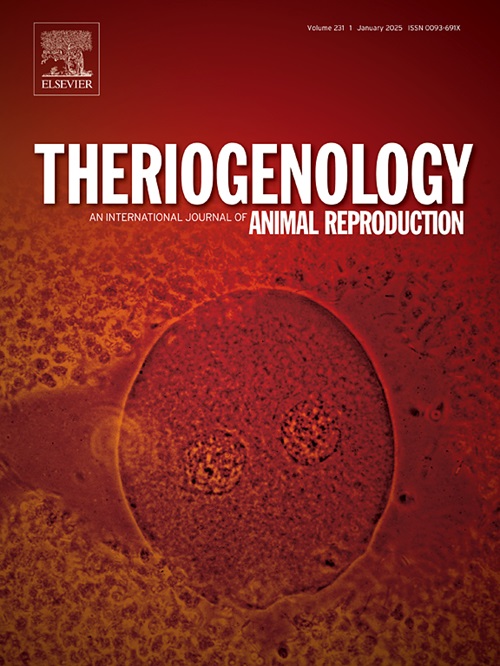Efficacy, safety and interval from end of treatment to estrus in cats treated with an ultra-low dose megestrol acetate protocol for suppression of reproductive activity
IF 2.4
2区 农林科学
Q3 REPRODUCTIVE BIOLOGY
引用次数: 0
Abstract
Cat breeders need safe, predictable and fully reversible temporary control of reproduction in queens. Megestrol acetate (MA), a short-acting progestogen was investigated in this study designed to determine whether low-dose treatment is both effective and safe in cats for periods up to 6 months. Twenty-eight queens were treated orally with 11.5 μg/kg/day of MA for one to six months. A physical examination, vaginal cytology, and reproductive ultrasound were performed before, during and after treatment, whilst urinalysis and hematological/biochemical tests, including progesterone assay, were performed before and after treatment. MA suppressed reproductive function effectively in 27/28 queens. Transient mammary and uterine hyperplasia were detected in four (14 %) and three (11 %) queens, respectively, treated for more than four months, without associated clinical signs. Pyometra was observed in only one queen following her first estrus cycle post-treatment. Significant but reversible weight gain was observed in 85 % of the animals. The resumption of cyclicity occurred on average 6 weeks after the end of treatment but was influenced by the duration of treatment and seasonality. An ultra-low dose MA treatment was effective in suppressing estrus in queens treated up to 6 months. Close monitoring should be paid to queens treated for longer than 4 months as the incidence of side effects, albeit minor and manageable, increases thereafter. Mammary gland assessment and progesterone assay are indispensable before treatment. Fertility is preserved, making MA a valuable option for temporary control of reproductive activity in queens, who otherwise cycle continuously leading to both unwanted behavior and pregnancies.
超低剂量醋酸甲地孕酮治疗猫的生殖活性抑制的有效性、安全性和从治疗结束到发情的间隔
猫饲养者需要安全的、可预测的、完全可逆的临时控制母猫的繁殖。醋酸甲地孕酮(MA)是一种短效孕激素,本研究旨在确定猫在长达6个月的时间内低剂量治疗是否有效和安全。28只蜂王口服11.5 μg/kg/天MA,疗程1 ~ 6个月。在治疗前、治疗中和治疗后分别进行体格检查、阴道细胞学检查和生殖超声检查,同时在治疗前和治疗后进行尿检和血液学/生化检查,包括黄体酮测定。MA有效抑制了27/28只蜂王的生殖功能。四名(14%)和三名(11%)王后分别检测到短暂性乳腺和子宫增生,治疗超过四个月,无相关临床症状。在治疗后的第一次发情周期中,只有一只蜂王出现子宫积脓。在85%的动物中观察到显著但可逆的体重增加。周期恢复平均发生在治疗结束后6周,但受治疗时间和季节性的影响。超低剂量MA治疗可有效抑制雌蜂发情达6个月。对于治疗超过4个月的蜂王,应密切监测,因为此后副作用的发生率增加,尽管轻微和可控。治疗前乳腺检查和黄体酮检测必不可少。生育能力得以保留,使MA成为暂时控制女王生殖活动的一个有价值的选择,否则女王会不断循环,导致不想要的行为和怀孕。
本文章由计算机程序翻译,如有差异,请以英文原文为准。
求助全文
约1分钟内获得全文
求助全文
来源期刊

Theriogenology
农林科学-生殖生物学
CiteScore
5.50
自引率
14.30%
发文量
387
审稿时长
72 days
期刊介绍:
Theriogenology provides an international forum for researchers, clinicians, and industry professionals in animal reproductive biology. This acclaimed journal publishes articles on a wide range of topics in reproductive and developmental biology, of domestic mammal, avian, and aquatic species as well as wild species which are the object of veterinary care in research or conservation programs.
 求助内容:
求助内容: 应助结果提醒方式:
应助结果提醒方式:


